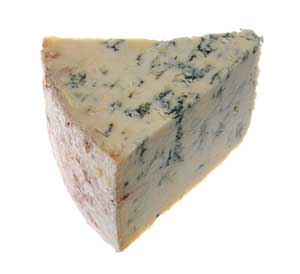Blue Cheese
 |
The large family of blue cheeses (including the well-known English Stilton) is revered around the world. A special mold culture imparts the tangy flavoring that pairs especially well with sweets and fresh fruits. |
Blue cheeses are those with mold – streaks of Penicillium culture (usually P. roqueforti) – running throughout. They are made from cow, goat, or sheep's milk, which may or may not be pasteurized. Many are aged at least a few weeks (some many months) in environmentally controlled caves. Flavoring ranges from mildly tangy to pungent and most are salty.
Traditionally, the blue or green veining is achieved by folding mold culture into the curds, or by needle injections after the wheels and loaves are formed.
Varieties
The “blue” or “blued-veined” cheeses are also called “fromage bleu” or Persille (which means parsleyed in French), “Edelpilzkase” (German) and “Azul” (Spanish).
Within each region, many variants are produced. The following are the most readily available.
Danish Blue (Danablu) – A cow’s milk cheese that is sold around the world. Can be sliced or crumbled. Blue Castello is another popular Danish variety that is exceptionally high in fat and milder than most. Saga Blue is recommended for those who are hesitant to try a blue cheese.
Gorgonzola – An Italian cheese with several varieties from Dolce (mild) to Piccante (spicy). An outstanding dessert cheese, but also can crumble for salads.
Maytag – A well-respected American blue. Made from cow’s milk in much the same way as Roquefort. Mold is injected and the cheeses age in caves. Creamy and firm enough to spread, but also good for crumbling in salads.
Roquefort – The most famous French cheese. Made from unpasteurized sheep milk and aged in limestone caves. A classic dessert cheese that is now included in salads and dressings.
Stilton – English and the best-known of all the blues. Pairs best with port wines. White Stilton is a young variety with no veining. Other English cheeses are Shropshire Blue, Blue Cheshire, and Wensleydale. Use in salads and for table service.
Buying Tips
Visit reputable cheese shops for the best cheeses and greatest variety. A tasting is often allowed to judge the quality. The country of origin should be visibly marked. Always sniff the cheese – over ripening produces an ammonia smell. Cheese past its prime can sweat, look hard, and have surface cracks.
Storage Tips
Blue cheeses should be consumed within a few days of purchase. Refrigerate in the original wrapper or cover with aluminum foil that has been pricked with several small holes. Most will freeze, but may not retain the original consistency. Those that become too crumbly can be used in salads.
Usage Tips
• Allow blues to come to room temperature before serving.
• Blue cheeses are available in a range of prices. Use the less ex





